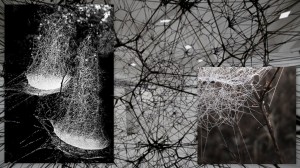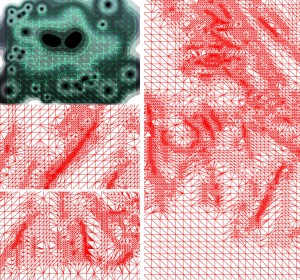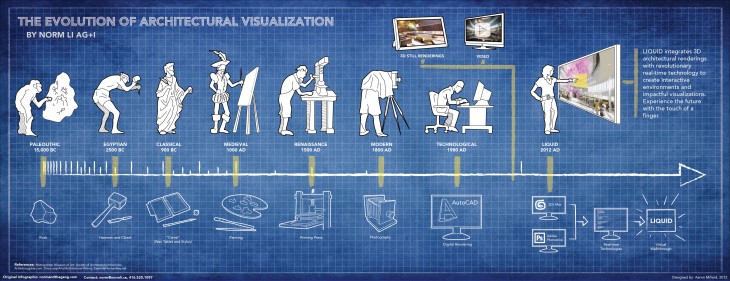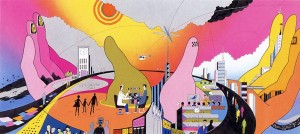Gilles Deleuze and Félix Guattari describe the space as a diversity of lines, which each get their identity from the environment. They describe the complete set of connections of particles as the Rhizome. Read More
Learning from a potato
T6- Schumaker parametricism- A new global style for architecture and urban design
Simple complexity.
Patrick Schumacher explains parametric. It’s an Abstract symmetry.
Systematic innovation which is the style for the present and the future. Architecture and urbanism are called upon to organize and articulate the increased complexity of the society and parametric should be the style used.
The first thing for which the style is recognized is for its aesthetics, it is a very long term style of design. Long term as it does not depend on the scale. It can be used on an urban level, may it be to design an individual project or an interior project or even a piece of furniture.
Patrice talks about the style, constantly contradicting at every step. “continuous differentiation”
The style has a certain elegance to it, having a ordered complexity. The connections to it. Every minute connection within themselves are important and unique. The style gives way to intricate options, opening up various probabilities. The internal connections or routes make the whole in large so complex to understand. Because of the very complexity Patrick keeps on referring the need of technologies used in this particular style. How technical knowledge makes the difficult standardization open and easy to perceive.
The second thing: fluidity
the style is a free flowing form. Innate to its preceding styles. he talks about the modern style. How a rigid geometry was the basis of the designing strategies of the styles. On the contrary this style is a natural flowing system. With not one element similar. It is inspired by the natural path taken. He talks about peoples straight forward, goal oriented path and “the donkeys path” . The organic hold to this style is the very derivative from the world around. He talks about liquids in motion, structure that are formed by radiating waves, laminal flows.
The third he talks about is deformation:
Deformation is not breaking of order but it is in fact the lawful inscription of information. The deformation is necessary in the scale as whole, when a more densely oriented area needs more connections hence more complex structure than a scarcely dense area. Making the whole structure of the form deformed.
Parametric being a very complex, well patterned style. it consists of methodologies and some rules. The style takes into consideration the old principals which need to be preserved. Every style has its hard core set of rule books and the way of tackling problems. The rules both being positive and negative.
Negative: the negative part is to avoid basic geometry like square, triangle and circles. To avoid repetition of the elements.
Parametric is best used on an urban scale. The larger the scale the more capacity to articulate programmatic complexity.
Parametric on an urban scale helps construct new fields of operating. The different system: fabric modulation, street system, open space relationships. He further talks about the massing, how details are part of the style. The orientation, climatic and visual. The thought given in the entrance and the internal circulation (small detailed things) . The deep relationship between the minute things.
Emergence by Steven Johnson – ignorance is sometimes good. Its better to have a simple element, which is thus interconnected to form a complex pattern. Which the text gives an example of the life of ants. How ignorance is better in making the thing simpler on a smaller scale, and then gets complex moving up.
Parametric can have a similar approach. The simpler elements can merge to make a complex whole. And the whole itself can be made easier to understand by the technologies available now. The complexity can be broken down to understand and use It better.
Topic of interest.
If taken into an urban scale, to see how the densely formed areas behave on the contrary to the areas less dense. Would the complexity increase with the increase of elements or would it be simpler.
How to make a dense space simpler and a simple space complex. Just so it either merges with each other or contradicts their existence.
EMERGENCE. Steven Johnson
\\ Non Lienar growth with algorithms \\
SUMARY
The idea of the text is a metaphor between the behavior of ant colonies, animal cells, humans and cities. On the whole, the people as the ants, think locally and act locally, but their collective action produces global behavior. The scale of knowledge is reduced in the individuals, but the city has his own intelligence driven by thousands of people who act in different fields producing changes in them. Neighborhoods are themselves polycentric structures, born of thousands of local interactions, shapes forming within the city larger shape.
MORE THAN JUST TOOLS
Photo : http://normandthegang.com/2012/07/05/the-evolution-of-architectural-visualization/ by NORM LI AG+I
Text under study: TOWARD A THEORY OF ARCHITECTURE MACHINES by Nicholas Negroponte
With the evolution of architecture it can be clearly observed that not only has the architecture developed over time but so has the technology that helps in creating the design.
The technology refers to a number of items that would include materials, techniques and most prominently the digital tools that are used by almost all the architects today.
Nicholas Negroponte envisioned this growth in 1969 in his “towards theory of Architecture Machines” where in he not only anticipated computer aided design but also artificial intelligence.
The idea of the machine proposed is not merely a tool that does redundant tasks those which are already done by the designer. The machine in fact provides useful inputs and aids in the design process. They not only learn from the user but also improvise and evolve with the user themselves. Therefore it acts a means to expand the creativity of the user. Read More
IGNORATO MOTU, IGNORATUR NATURA*
As in the seventeenth century Galileo wrote “The Book of Nature is written in characters of Geometry“, so the Scottish biologist D’Ancy W. Thompson, almost four centuries later, undertook a study focused on the use of mathematics to describe what is still a recurring theme: the “evolution”. He pushed himself to the limits of research with the ambition to find a “scheme” of Nature (“On Growth and Form” published on 1917).
The chapter in point is “Comparison of the related Forms“, where Thompson, inspired by the work of the artist Albrecht Dürer, explores the degree to which differences in the forms of related animals could be described by means of relatively simple mathematical transformation.
After fixing (drawn) on a classical cartesian plane his study models (bones, skulls, fishes), he proceeded with linear transformations and affine transformations, rotations, reflections and translations, which were going to change the design of the basic model in a new design attributable to a different characteristics model, but of the same biological “family” (i.e. from the cannon-bone of ox to a cannon-bone of sheep).
Doing so he reported four different methods of deformation of the cartesian plane: transformation with linear function; logarithmic increase; when the rectangular coordinates become “oblique” and their axes have a Certain angle “w” and transformation to radial coordinates with one focus point.
Concisely, starting from a rigid mathematical and geometrical view, the biologist investigated new meanings of forms in nature trying to give them “mathematical names.”
As we have already seen for Rudofsky, the method of analysis and work is the same as the one used here by Thompson, ZOOM IN and ZOOM OUT, which we can compare, in affinity and practical significance, with the short film directed by Ray and Charles Eames (“Powers of Ten” – http://www.powersof10.com/film).
An holistic view is essential to issues such as Form and Nature, Science and Art, Human Being and Society.





